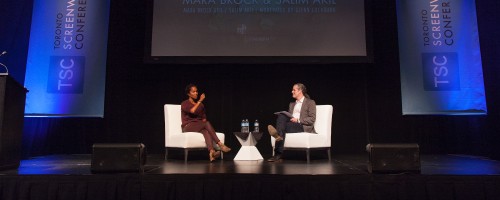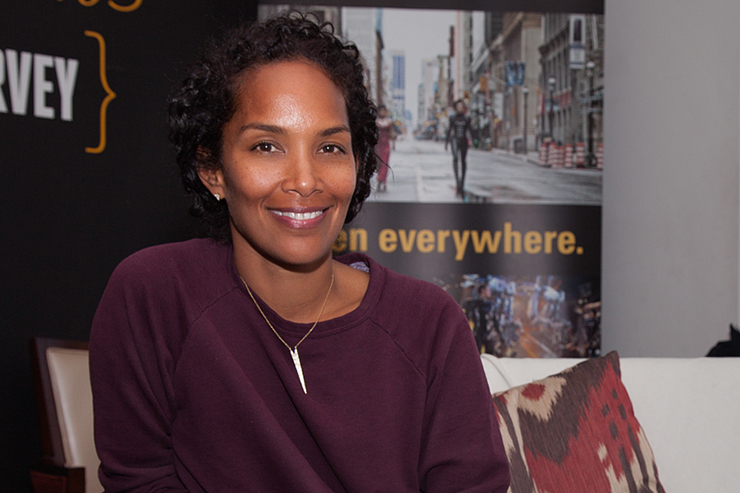The year is 1994. A young, ambitious junior screenwriter, Mara Brock Akil, sits in a room with seasoned television executives discussing an upcoming episode of the short-lived sitcom “South Central” – a show about an African-American family’s everyday life in the Los Angeles area of the same name.
It’s time for one of the male characters to write a letter expressing his ‘young love’ for a girl and the senior screenwriters are debating – which slowly turns into arguing – what the letter should actually say.
“I was just listening and I was nervous to get into the debate,” Akil remembers. “I was the baby [in the room] … but I understood what he wanted to say. Instead of pitching it, I wrote the letter sitting there at the table.”
In a “mousy” voice, Akil interrupted the ensuing arguments. “I have something,” she announced to the room.
“I’ll never forget the moments after I read the letter out loud to the room. The room was silent for – it felt like forever – but it was silent. And I knew at that point, even though I was a little nervous, I knew that I had won. I knew that I had impressed all of those people and I had done my job … we were stuck for a couple hours, and I was able to move the room forward. I knew at that moment that I had value.”
Fast forward two decades later. Today, Akil’s “value” is uncontested. A Kansas City native, who studied journalism at Northwestern University in Illinois, Mara Brock Akil is the creator of, and mastermind behind, hit series’ “Girlfriends”, “The Game” and, most recently, BET’s “Being Mary Jane” starring Gabrielle Union – now in production of its third season.
Together with her husband, Salim, Mara Brock Akil is hard at work building up her production house, Akil Productions, as an industry mainstay.
“What I took away from [Mara was] to really push the boundaries and prove to the wider audience that our stories are not only valid, but they’re needed.” – Motion
“Often we’re told, for example, that Black women leads, complex Black women characters, stories about Black people or people of colour that are more than one or two dimensional cannot make it to the screen or cannot sell. I think her body of work … has proven this to be possible,” says playwright and poet, MOTION, who attended the 2015 Toronto Screenwriting Conference’s keynote talk with Akil.
“What I took away from [Mara was] to really push the boundaries and prove to the wider audience that our stories are not only valid, but they’re needed. People want to see those voices right now.”
Relatable Truths
Akil utilizes the platform she has – having amassed an enormous audience for her shows – to tackle serious social issues and complex current affairs through entertaining and engaging characters, plots and dialogues.
During her keynote interview, she speaks to her journalist background – which inspires her to dig deeper into the issues that really matter to her. In just two seasons of “Being Mary Jane”, for instance, the show has touched on everything from sex trafficking of teenage girls to deep-rooted systemic racism in major news organizations.
Mara seeks a high calibre of storytelling from her team, now that she is no longer the ‘baby’ in the screenwriting room, but rather the one running the show.
“I’m looking for original thought; I’m looking for honest, relatable truth,” she explains in a sit-down interview, after her keynote. “I’m looking for people to get below the surface … Sometimes you can hear when they’re trying to regurgitate something they saw in somebody else’s movie, or they just feel like something has to happen – but I’m like, what would happen is the real question … Have we explored the human emotion or are we just moving the plot?”
This approach is demonstrated in the high level of transparency seen in “Being Mary Jane”. The show uses things like glass walls and mirrors to allow the viewer a glimpse into the innermost, personal moments of Mary Jane’s life – flaws and all.
The last season of the show had several scenes of depicting complex everyday life scenarios that emotionally moved Mara, she says, where the execution of her screenwriting surprised even her. The ‘break-up’ scene between Mary Jane and her work/life best friend Kara, who have an antagonistic, sisterly relationship, or the ‘coming out’ scene of Mary Jane’s neighbour/colleague Mark to his parents – both examples of this.
“When it’s better than even I can imagine, I get really excited about that,” says Akil. “When the writing, the acting, the directing and the props even, when everything comes together, I’m thankful.”
Standing For Something
While today Mara is very much in control of her artistic works, it wasn’t always like this. She reflects back on the early days of working on the first show she created, “Girlfriends” – an eight-season show set at the start of the new millennium chronicling the lives of four women, in which the lead character Joan is on the quest of ‘having it all,’ namely a successful career, marriage and motherhood. Though it was her show, the television network (UPN) was very much in control in the beginning.
It’s indicative of a struggle between creative control and the corporate entertainment world many artists know all too well.
“It’s something that we all [go through]– whether you’re in this business or not – there has gotta be a line that you’re just not willing to cross or you are willing to walk away.” – Mara Brock Akil
“Keenan Ivory Wayans – I met him early in my career – he told me you will learn the power of no and when to use it,” Akil says. “It’s something that we all [go through]– whether you’re in this business or not – there has gotta be a line that you’re just not willing to cross or you are willing to walk away. When is it too much?”
For Mara, that moment was heading into the third season of “Girlfriends”. According to her, when she started at the network it was under the condition that she would, “take her show back,” after two seasons of learning the ropes; when the time came, she was forced, instead, to “battle” for full control. And she was prepared to walk if the network didn’t let go.
“It was calculated though – because I was successful,” she says, laughing. “It was a gamble, but I knew I could win that one. I couldn’t have said that season one; they would have been like, ‘bye!’”
“America doesn’t look the way it’s often portrayed on the tube and people are not having it anymore.” – Mara Brock Akil
Bigger picture, Akil’s battle represents a larger fight – one for a place at the proverbial table for more diverse storytelling – something she says American, and global, audiences are calling for.
“America doesn’t look the way it’s often portrayed on the tube and people are not having it anymore.”
And this doesn’t mean duplicating what’s already been done, she notes.
“Right now in Hollywood the whole thing is, ‘where’s my next “Empire?’” she says. “Empire, Empire, Empire … [but] instead of it just being a copycat, where is the next innovation? What’s the next idea that should be reflective of the community?”
More than likely, that “next idea” is cooking up inside the Akils’ production house.
Photos & Video By. Isa Ransome © Urbanology Magazine






Comments are closed.